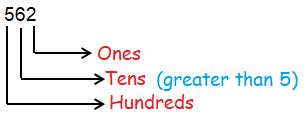ESTIMATION PROBLEMS WITH ONE FIGURE APPROXIMATION
What is one figure approximation ?
When estimating we usually round each number to one significant figure and evaluate the result. We call this a one figure approximation.
When estimating we usually round each number to one significant figure and evaluate the result. We call this a one figure approximation.
Rounding Two Digit Numbers
If the given number is two digit number, we have to round it to the nearest tens.
Step 1 :
To round it to the nearest tens, we have to look at the unit digit.
Step 2 :
If the unit digit is less than 5, then we have to keep the ten's digit as it is and convert the remaining places as 0.

So, approximating it as 30.
If the unit digit is greater than or equal to 5, then we have to add one with the ten's place and change the remaining digits as 0.

Approximating it as 30
Rounding Three Digit Numbers
Step 1 :
If the given number is three digit number, we have to round it to nearest hundreds and so on.
Step 2 :
To round it to the nearest hundreds, we have to look at the tens digit.
If the tens digit is lesser than 5, then we have keep the hundreds place as it is and change remaining digits as 0.

So, approximating it as 400.
If the tens digit is greater than or equal to 5, then we have to add one with the hundred's place and change the remaining digits as 0.

So, approximating it as 600.
Estimate using a one figure approximation :
Problem 1 :
22 x 394
Solution :
= 22 x 394
Rounding to one significant figure,
= 20 x 400
= 8000
Problem 2 :
218 x 74
Solution :
= 218 x 74
Rounding to one significant figure,
= 200 x 700
Problem 3 :
58 x 3102
Solution :
= 58 x 3102
Rounding to one significant figure,
= 60 x 3000
= 180000
Problem 4 :
2360 x 21
Solution :
= 2360 x 21
Rounding to one significant figure,
= 2000 x 20
= 40000
Problem 5 :
3904 x 541
Solution :
= 3904 x 541
Rounding to one significant figure,
= 4000 x 500
= 2000000
Problem 6 :
612 ÷ 29
Solution :
= 612 ÷ 29
Rounding to one significant figure,
= 600 ÷ 30
= 20
Problem 7 :
230 ÷ 54
Solution :
= 230 ÷ 54
Rounding to one significant figure,
= 200 ÷ 50
= 4
Problem 8 :
64183 ÷ 595
Solution :
= 64183 ÷ 595
Rounding to one significant figure,
= 60000 ÷ 600
= 100
Problem 9 :
27830 ÷ 426
Solution :
= 27830 ÷ 426
Rounding to one significant figure,
= 28000 ÷ 400
= 70
Problem 10 :
Hong Kong has an area of 1104 km2. An average of 6349 people live in each square kilometer. Estimate the total population of Hong Kong.
Solution :
Total area of Hong Kong = 1104 km2
Average number of people live in 1 square kilometer = 6349
Total population = 1104 x 6349
Since we are estimating the population, we can round for one significant figure.
= 1000 x 6000
= 6000000 people
So, the total population of Hong Kong is 6000000 people.
Problem 11 :
There are 29 students in a class. Each student has an average of 11 books. Estimate the total number of books.
Solution :
Number of students in the class = 29
Number of books on average = 11
Total number of books = 29 x 11
Approximating to one significant figure, we get
= 30 x 10
= 300
So, the total number of books is 300.
Problem 12 :
The teacher spends a total of 292 minutes making these 12 assignments. Estimate using a one figure approximation, the average time spent making each assignment.
Solution :
Time spent for making assignments = 292
Number of assignments making = 12
Time taken to make each assignment = 292 ÷ 12
Rounding to one significant figure, we get
= 300 ÷ 10
= 30 minutes
So, time spent for making each assignment is 30 minutes.
Problem 13 :
559 eggs are divided equally between 43 baskets. Estimate the number of eggs in each basket.
Solution :
Number of eggs to be divided = 559
Number of baskets available = 43
Number of eggs in each basket = 559 ÷ 43
Rounding for one significant figure, we get
= 600 ÷ 40
= 15
So, the number of eggs in each basket is 15.
Problem 14 :
The month of December has 31 days. Estimate the number of seconds in December. Compare your estimate with correct value.
Solution :
Number of days in December = 31
Number of hours in one day = 24 hours.
1 hour = 60 minutes
1 minute = 60 seconds
To convert hour to seconds, we have to multiply by 3600.
Total number of seconds in December = 31 x 3600
= 111600 seconds ----(1)
Estimating the number of seconds :
Rounding to one significant figure, we get
= 30 x 4000
= 120000 seconds-----(2)
In (1), approximating the figure, we get 120000 seconds.
Recent Articles
-
Finding Range of Values Inequality Problems
May 21, 24 08:51 PM
Finding Range of Values Inequality Problems -
Solving Two Step Inequality Word Problems
May 21, 24 08:51 AM
Solving Two Step Inequality Word Problems -
Exponential Function Context and Data Modeling
May 20, 24 10:45 PM
Exponential Function Context and Data Modeling